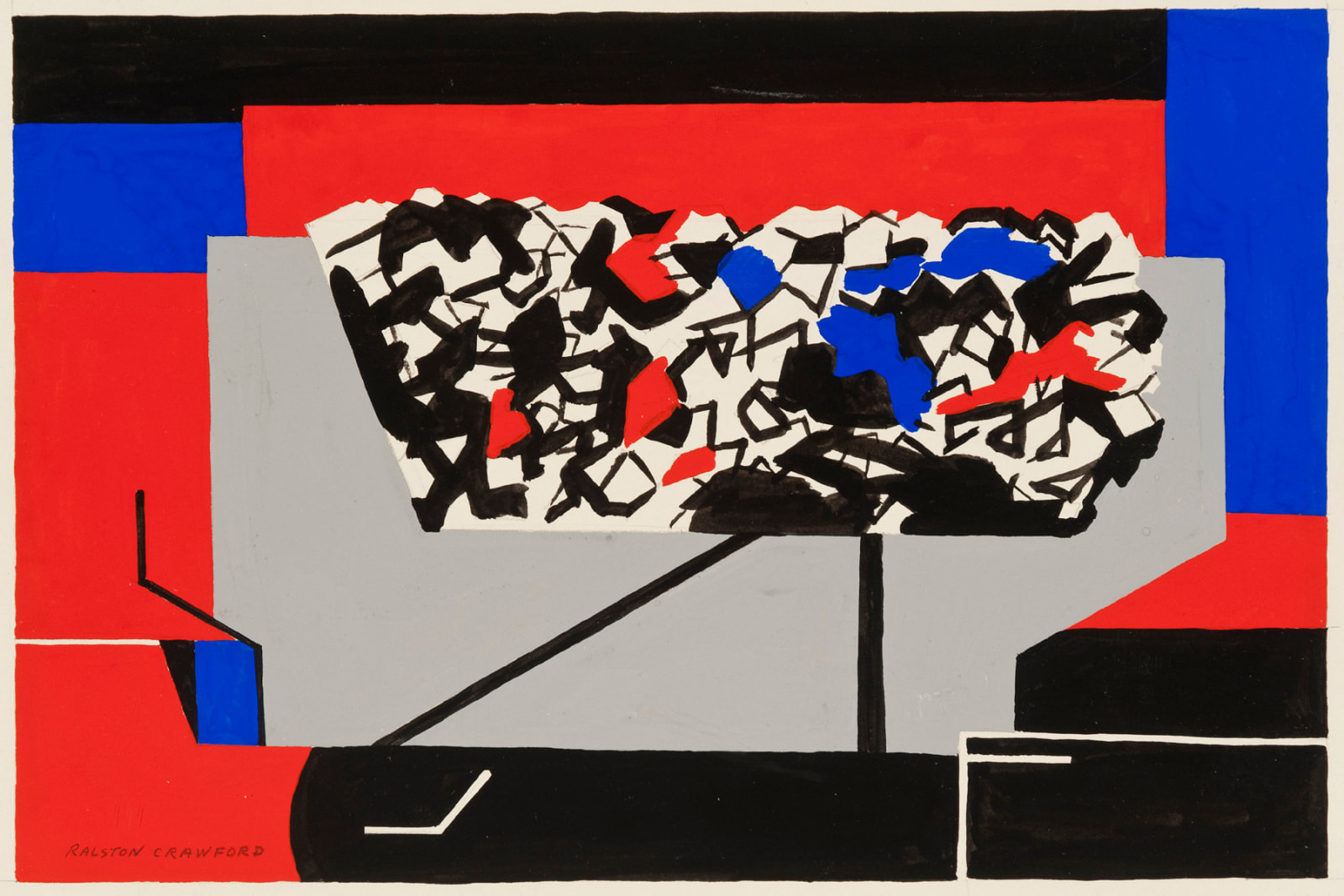Ralston Crawford American, 1906-1978
Coal Car, 1945
Gouache on paperboard
11 x 15 inches
Framed Dimensions:
19 3/4 x 24 3/4 x 1 inches
Framed Dimensions:
19 3/4 x 24 3/4 x 1 inches
Signed at lower left: RALSTON CRAWFORD
Ralston Crawford’s career spanned from an early association with Precisionism to a more abstract post-war body of work. His finest works incorporate some lessons drawn from the crucible of Sheeler...
Ralston Crawford’s career spanned from an early association with Precisionism to a more abstract post-war body of work. His finest works incorporate some lessons drawn from the crucible of Sheeler and Demuth, while pressing beyond elegies to nascent American industry. He retained a love for sharp edges and clean fields of color, but his career experienced renewed attention as he delved deeper into the experience of visualizing, allowing observed forms to dissolve into almost entirely abstract imagery.
The final years of the war represented a time of upheaval for Ralston Crawford. While his earlier work joined in the elegiac mood of the Precisionist camp, World War II, and particularly the rise of nuclear weapons, shifted his attitude about life as well as his method of working. Though he continued to work from industrial scenes, his work increasingly focused on damaged and degraded structures – peeling billboards and crumbling buildings. The end of the war, too, marked the beginning of a period of great experimentation for the artist in other media. The older idioms seemed to be inadequate for expressing the realities and anxieties of the new age, and the still young artist was eager as ever to discover new modes of personal expression. He took up print-making, using lithography to clarify his masses of uninterrupted color, and photography, working a variety of croppings to excavate the formal potential of a particular view.
In this process of self-reassessment, Coal Car is a keystone work. It starts, as did many of Crawford’s pre-war works, with an consideration of an industrial scene – in this case, a bucket-car for carrying coal along rail tracks, possibly on a freight line, or of the type that miners use. The object itself is legible in the work, but recognition of the subject is secondary to the act of looking itself. The artist has already grown into his mature compositional powers, using the entire frame of the image to activate blocks of color, and the color he employs is bold and brilliant. Choosing a palette not unlike Debuffet, he steps away from the local color of the object itself, endowing a soot-black machine with a pop-like effervescence – an alchemical change from coal to Brillo Box. The center of the composition displays total discord, as if a nod to nascent Abstract Expressionism. It is nonetheless controlled and considered, polished to Crawford’s characteristic brilliance, rather than an explosion of expression. The gouache represents a post-war artist, with a clear view of the future, addressing a motif of the prewar generation. Ralston Crawford, a prisoner of neither era, masterfully rises to the occasion.
The present work is listed in The Downtown Gallery's Stockbook, no. 45 of listing of Crawford's work received at the gallery.
The final years of the war represented a time of upheaval for Ralston Crawford. While his earlier work joined in the elegiac mood of the Precisionist camp, World War II, and particularly the rise of nuclear weapons, shifted his attitude about life as well as his method of working. Though he continued to work from industrial scenes, his work increasingly focused on damaged and degraded structures – peeling billboards and crumbling buildings. The end of the war, too, marked the beginning of a period of great experimentation for the artist in other media. The older idioms seemed to be inadequate for expressing the realities and anxieties of the new age, and the still young artist was eager as ever to discover new modes of personal expression. He took up print-making, using lithography to clarify his masses of uninterrupted color, and photography, working a variety of croppings to excavate the formal potential of a particular view.
In this process of self-reassessment, Coal Car is a keystone work. It starts, as did many of Crawford’s pre-war works, with an consideration of an industrial scene – in this case, a bucket-car for carrying coal along rail tracks, possibly on a freight line, or of the type that miners use. The object itself is legible in the work, but recognition of the subject is secondary to the act of looking itself. The artist has already grown into his mature compositional powers, using the entire frame of the image to activate blocks of color, and the color he employs is bold and brilliant. Choosing a palette not unlike Debuffet, he steps away from the local color of the object itself, endowing a soot-black machine with a pop-like effervescence – an alchemical change from coal to Brillo Box. The center of the composition displays total discord, as if a nod to nascent Abstract Expressionism. It is nonetheless controlled and considered, polished to Crawford’s characteristic brilliance, rather than an explosion of expression. The gouache represents a post-war artist, with a clear view of the future, addressing a motif of the prewar generation. Ralston Crawford, a prisoner of neither era, masterfully rises to the occasion.
The present work is listed in The Downtown Gallery's Stockbook, no. 45 of listing of Crawford's work received at the gallery.
Provenance
The artist; toHis estate; to
[Hirschl and Adler Galleries, New York]; to
Private collection, in 1997
Exhibitions
Santa Barbara Museum of Art, 1946, Ralston Crawford: Paintings. (This exhibition traveled to the M.H. de Young Museum, San Francisco)Subscribe to our mailing list to receive updates from the gallery
* denotes required fields
We will process the personal data you have supplied in accordance with our privacy policy (available on request). You can unsubscribe or change your preferences at any time by clicking the link in our emails.

